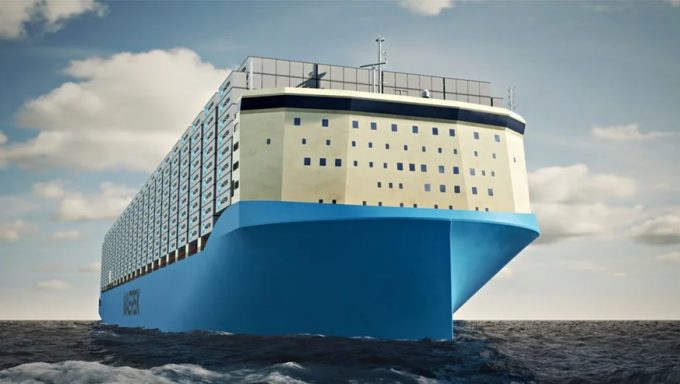Container spot rates have peaked as all major trades see prices fall
There was more evidence in this week’s container port freight markets that peak prices on ...
TFII: SOLID AS USUALMAERSK: WEAKENINGF: FALLING OFF A CLIFFAAPL: 'BOTTLENECK IN MAINLAND CHINA'AAPL: CHINA TRENDSDHL: GROWTH CAPEXR: ANOTHER SOLID DELIVERYMFT: HERE COMES THE FALLDSV: LOOK AT SCHENKER PERFORMANCEUPS: A WAVE OF DOWNGRADES DSV: BARGAIN BINKNX: EARNINGS OUTODFL: RISING AND FALLING AND THEN RISING
TFII: SOLID AS USUALMAERSK: WEAKENINGF: FALLING OFF A CLIFFAAPL: 'BOTTLENECK IN MAINLAND CHINA'AAPL: CHINA TRENDSDHL: GROWTH CAPEXR: ANOTHER SOLID DELIVERYMFT: HERE COMES THE FALLDSV: LOOK AT SCHENKER PERFORMANCEUPS: A WAVE OF DOWNGRADES DSV: BARGAIN BINKNX: EARNINGS OUTODFL: RISING AND FALLING AND THEN RISING

As part of a wider shift toward green methanol as its future fuel of choice, Maersk has unveiled a new 16,000 teu green-methanol ship design.
It puts the crew accommodation and funnel at opposite ends of the vessel, a move the shipping giant says will improve capacity and port and fuel efficiency.
The vessel will be able to operate on dual-fuel, incorporating conventional low-sulphur and green methanol.
Meanwhile the bow-mounted accommodation is swept at the sides to improve aerodynamic efficiency, similar to a truck cab, while the funnel at the back of the vessel on the port side, creates space for additional container stacks to the right. Maersk claims this will increase efficiency per transported container by 20% over the industry average.
Rearranging the accommodation and funnel creates a contiguous area for containers, rather than splitting them with a central superstructure, which Maersk’s designers say will improve the efficiency of crane movements in ports.
However, the unconventional placement of the superstructure does create a number of problems for designers, as not only are crews less shielded from waves, but potentially exposed to more pronounced pitching – the axial see-sawing motion along the length of the ship. A superstructure located centrally also has a reinforcing effect on hull strength. But Maersk says it has considered ways of getting around this.
Further considerations include a new layout of lifeboats, as well as rear-facing cameras to support crew visibility.
The design features a 16,000 cubic metre methanol fuel tank, enabling the ship to travel long distances using the fuel – an important consideration, since it has less energy per kg than HFO or marine diesel. Maersk claims the vessel represents a further commitment to methanol as a fuel of the future, after it began construction of 2,000 teu methanol-powered feeder vessels.
An electro-fuel, green methanol is created by electrolysing seawater to create hydrogen and then binding it to CO2 – most likely supplied as exhaust from a fossil-fired power plant – using inputs of renewable energy.
Liquid at room temperature, methanol is more practical than hydrogen in terms of storage, with several times the energy density, as well as being less toxic than ammonia if spilled or inhaled. While methanol is only marginally more CO2-efficient than marine diesel or HFO at the point where it is emitted from the funnel, it gives a “second bite of the cherry” for a given quantity of CO2 emitted, effectively writing-off the ship’s emissions.
It is also clean-burning, emitting no NOx or SOx, and only minimal particulate matter.
Comment on this article